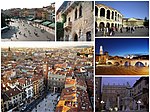Arco dei Gavi, Verona

The Arco dei Gavi is an ancient structure in Verona, northern Italy, situated at the beginning of the Via Postumia, just outside the Roman walls of the city. Built to celebrate the gens Gavia, a noble Roman family who had their hometown in Verona, the Arco dei Gavi is a very rare example of a privately funded monumental Roman arch.During the Renaissance the arch was one of the most admired monuments in Verona, being described by humanists and antiquarians, who studied in detail the proportional relationships and decoration of the structure. The arch served as inspiration for many architects and painters, such as Andrea Palladio, Antonio da Sangallo the Younger, Sebastiano Serlio, Giovanni Maria Falconetto, Michele Sanmicheli, Giovanni Bellini and Andrea Mantegna. It had a particularly pronounced influence on the architecture of Verona itself, serving as a model for the construction of portals, altars and chapels in the churches of the city.The arch no longer stands in its original position, as it was demolished by French military engineers in 1805, however, the numerous surveys that had previously been produced made it possible to reassemble it by anastylosis, a process completed in 1932. Subsequently, it was relocated to the small square of Castelvecchio, where it is still located today.
Excerpt from the Wikipedia article Arco dei Gavi, Verona (License: CC BY-SA 3.0, Authors, Images).Arco dei Gavi, Verona
Piazzetta Castelvecchio, Verona San Zeno
Geographical coordinates (GPS) Address Nearby Places Show on map
Geographical coordinates (GPS)
| Latitude | Longitude |
|---|---|
| N 45.44 ° | E 10.988888888889 ° |
Address
Piazzetta Castelvecchio
37122 Verona, San Zeno
Veneto, Italy
Open on Google Maps










